njswede
150cc
Pilot-RC Yak 54 19% (53")
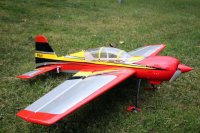
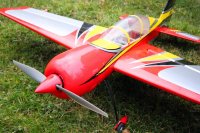
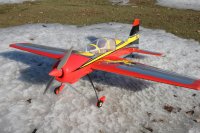
[h=1]Introduction[/h]
For this review, we thought we should try something a little bit different. After having browsed through the usual models from our favorite vendors, we decided to pick something a bit outside of the mainstream. Giant scale pilots are all familiar with the Pilot RC brand, but for the rest of us who only get to play with toys in the 50” class, it's a relatively unknown brand.
Our Yak was procured through Chief Aircraft, the main distributor of Pilot-RC in the US.
[h=2]Pilot RC[/h]
Pilot has made a name for itself with some spectacular giant scale models, such as a stunning 180” wing span Yak 54. The company is based in China and has established itself as a maker of “premium” models, primarily in the quarter-scale segment and upwards. They are also famous for their unique customer service policy, that basically states that if you crash your plane, they'll send you all the broken wood parts free of charge. You just have to pay shipping from China. We've seen from several people on the forums that this actually works. People have crashed their planes beyond recognition, emailed a picture to the factory and two weeks later a package containing replacement parts arrived at their doorstep. However, this is one of the aspects we hope we won't have to cover in this review...
[h=1]Unboxing[/h]
The aircraft comes in a thick cardboard box containing a custom made foam insert with compartments for wings, fuselage and control surfaces. This has to be one of the best packed aircraft we have ever seen and it should withstand even the most destructive and devious postal worker. Upon first inspection, all the parts seemed to be accounted for, with the glaring exception of the manual. It turns out that, like so many other vendors, Pilot has eliminated the paper manual in favor of a downloadable PDF version on its website. The manual is very detailed and richly illustrated. However, instead of supplying a manual for each aircraft type, Pilot RC has a single manual covering all the aircraft in the 50” class. Although the pictures are excellent and very helpful to the build, a bit more detailed description of some of the steps would be useful. Also, we would have preferred a bit more explicit information about what type of glue to use for the various steps.
We also noticed some wrinkles on the covering. This is normal for an ARF and is probably due to the fact that it was manufactured in a hot and damp climate and shipped to cold New Jersey. A quick date with the covering iron took care of it. About 300F with a sock on the iron seems the optimum temperature to work the wrinkles out.
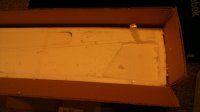
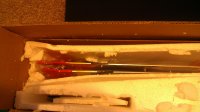
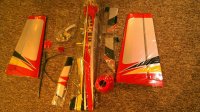
[h=1]Appearance[/h]
The color scheme we picked seems to have good contrast and a reasonable differentiation between the top and bottom of the wings. There are eight different color schemes available and Pilot also offers custom schemes for a fee, so you are sure to find a scheme that fits you. Unfortunately the classic and awesome Russian Thunder scheme was out of stock when we procured our plane.
In terms of scale appearance, this aircraft is more of “loosely inspired” by the full scale version than it is a true scale model. And there are probably very good reasons for this. The original Yak 54 is short and stubby and an exact scale model would probably have been very twitchy and hard to handle at 3D throws. This rendition of the Yak is considerably thinner, longer and sleeker than its full scale inspiration. Still, this is a very good looking aircraft that will definitely raise some eyebrows at the field.
Another thing that struck us is the unusually small elevator. Compared to other popular 3D models in the same size range, the elevator of the Pilot Yak 54 19% is about half the area. At first we were a bit concerned about the 3D performance of such a small elevator.
[h=1]Hardware and accessories[/h]
The hardware is top quality and consists of ball-links and very sturdy push-rods along with a pull-pull system for the rudder. Another nice feature we noticed was a small bag containing patches of covering material. This will come in handy when you want to fix those pesky cases of hanger rash, but don't feel like buying an entire roll of covering.
The hardware is very neatly packaged in a plastic bag with separate compartments for each phase of the build.
[h=1]Building the Aircraft[/h]
The build is fairly straightforward and presents few real challenges, at least if the builder already has a couple of ARFs under their belt. The ailerons come pre-installed and while some of the horns may need a little bit of trimming to fit into their slots, installation is almost trivial.
The model is designed for standard servos, so if you are planning on installing anything smaller, you need to use the supplied adapters. These are essentially just a small plywood frame that glues on top of the servo mounting hole. The adapters have pre-cut holes for micro servos, so if you’re using anything bigger, you’ll have to trim the holes. The best tool for this is probably a Dremel, but lacking a working Dremel, we just used a sharp knife. Unfortunately, the servo adapters aren’t mentioned in the manual, so a little bit of guesswork went into installing them. Again, if you're somewhat familiar with building ARFs, it's not going to be much of a problem.
We would also recommend you go over the motor box with some CA to strengthen the glue joints. We applied a generous amount along all the joints and let it seep in, before we hit it with kicker.
The firewall comes with a pre-drilled center hole, but no holes for the mounting screws. We appreciated this, since we're using a motor with an X-mount that is a little bit bigger than what's common for this size plane. Since the firewall comes with pre-drawn guidelines, measuring and drilling the holes is a breeze. There are blind nuts and wood spacers provided with the kit. We recommend gluing in the wood spacers with a very generous amount of epoxy before driving in the blind nuts. Also, make sure the neck of the blind nuts slide easily into the holes and don't try to force them in. We damaged one of the nuts this way, which could have been easily prevented by drilling out the hole to make sure the nut would slide in easily.
[h=1]Equipment[/h]
We decided to go with the following equipment:
Motor: HeadsUpRC FirePower 46. The manufacturer suggests the classic Hacker A30-12XL, which without doubt would have worked great. However, here at 3DRCForums, we're always looking exciting alternatives to the "standard" components, so we went for the less expensive and more powerful FirePower instead.
ESC: ZTW A-Series 70A. Economical and proven. A nice addition would be a BEC delivering 6V instead of the 5V this ESC puts out.
Servos: Hitec HS-5085MG. This is the one area we're not trying to save. Experience has shown it's always a bad idea.
RX: Spektrum AR6210.
[h=1]Flight and Performance Notes[/h]
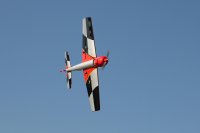
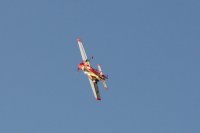
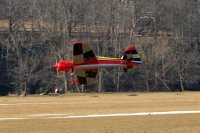
For the maiden, we had installed a 3000mAh 4s battery pack and we quickly realized (after a short but very scary tail heavy flight) that the battery needs to be pushed almost all the way forward to balance with the setup we had chosen. The good news is that this opens up possibilities for those who want to go with an even more powerful and slightly heavier power system.
Once we got the plane balanced and applied a couple of clicks of elevator and aileron trim, the plane was tracking very nicely and showed great control authority. In fact, the aileron response is so violent that we may have to turn down the high rates a bit. We ended up flying it at 70% rates and that was about as much deflection we dared to give it. The rolls are just of of control violent!
Spins and blenders are done with ease. In fact, the blender was extremely tight and perfectly axial with the plane spinning around a point right under the canopy.
When we did our flight testing, the wind was gusting up to 15-20mph, which made it challenging to determine stability in harrier and hover flight. However, elevators are very crisp and the harriers we were able to do didn't show any signs of wing rock. But it was fairly hard to tell, as the plane was tossed around in the turbulence quite a bit. Also, as far as we were able to tell, elevator response is very good even in stalled flight. In fact, the plane was able to maintain nose-up attitude in an elevator maneuver with about half elevator and maybe 10-20% throttle.
There was some coupling in KE flights, which is to be expected with a round fuselage. However, due to the gusty winds and turbulence, it was hard to determine what was coupling and what was just the wind pushing the wing area of the plane.
Since the weather conditions were not optimal during our test flight, we plan to do another round of flight reviews. However, what we were able to see so far was very promising!
The stock wheels and pants adds to the characteristic Yak look, but don't work that well unless your runway is paved or smooth as PGA tour golf green. For better performance on grass, you will probably want to modify the landing gear by changing to bigger wheels and getting rid of the wheel pants.
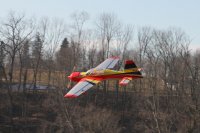
[h=2]Power System Performance[/h]
The FirePower 46 Sport from HeadsUpRC we installed in this plane turned out to be a nice surprise! Even with the slightly conservative prop choice of an APC 14x7E, it packed an impressive punch and pulled the plane out of hovers with ease. Given its sturdy construction around an 8mm shaft, this motor may be a good choice for those looking for a budget alternative to the big names. However, before you decide to buy this motor, make sure it fits in your plane, since it features a much larger X-mount than other motors in its class.
[h=1]Conclusion[/h]
Pilot-RC has always impressed the RC world with gorgeous and spectacular giant scale models. With their new series of 19% models, us mere mortals who don't have the room for an 180" wing span planes can finally enjoy these superbly built models. The 19% Yak 54 is an absolutely stunning model with great flight characteristics and looks that will keep even the loudest members of he peanut gallery at a loss for words!
Pros:
* Awesome looks! This plane really stands out among all the other Yaks, Extras and Edges in the 48"-53" segment.
* Great flight characteristics
* Very reputable vendor with legendary customer service
* A fun plane to build!
Cons:
* Supplied wheels are too small for grass fields.
* The manual needs a little work to reach perfection.
[h=1]Links and References[/h]
Pilot-RC web site: http://www.pilot-rc.com/
Chief Aircraft (U.S. distributor): http://www.chiefaircraft.com/
© www.3DRCForums.com
Some items received by 3DRCForums for review, were provided for free or at a discount.



[h=1]Introduction[/h]
For this review, we thought we should try something a little bit different. After having browsed through the usual models from our favorite vendors, we decided to pick something a bit outside of the mainstream. Giant scale pilots are all familiar with the Pilot RC brand, but for the rest of us who only get to play with toys in the 50” class, it's a relatively unknown brand.
Our Yak was procured through Chief Aircraft, the main distributor of Pilot-RC in the US.
[h=2]Pilot RC[/h]
Pilot has made a name for itself with some spectacular giant scale models, such as a stunning 180” wing span Yak 54. The company is based in China and has established itself as a maker of “premium” models, primarily in the quarter-scale segment and upwards. They are also famous for their unique customer service policy, that basically states that if you crash your plane, they'll send you all the broken wood parts free of charge. You just have to pay shipping from China. We've seen from several people on the forums that this actually works. People have crashed their planes beyond recognition, emailed a picture to the factory and two weeks later a package containing replacement parts arrived at their doorstep. However, this is one of the aspects we hope we won't have to cover in this review...
[h=1]Unboxing[/h]
The aircraft comes in a thick cardboard box containing a custom made foam insert with compartments for wings, fuselage and control surfaces. This has to be one of the best packed aircraft we have ever seen and it should withstand even the most destructive and devious postal worker. Upon first inspection, all the parts seemed to be accounted for, with the glaring exception of the manual. It turns out that, like so many other vendors, Pilot has eliminated the paper manual in favor of a downloadable PDF version on its website. The manual is very detailed and richly illustrated. However, instead of supplying a manual for each aircraft type, Pilot RC has a single manual covering all the aircraft in the 50” class. Although the pictures are excellent and very helpful to the build, a bit more detailed description of some of the steps would be useful. Also, we would have preferred a bit more explicit information about what type of glue to use for the various steps.
We also noticed some wrinkles on the covering. This is normal for an ARF and is probably due to the fact that it was manufactured in a hot and damp climate and shipped to cold New Jersey. A quick date with the covering iron took care of it. About 300F with a sock on the iron seems the optimum temperature to work the wrinkles out.



[h=1]Appearance[/h]
The color scheme we picked seems to have good contrast and a reasonable differentiation between the top and bottom of the wings. There are eight different color schemes available and Pilot also offers custom schemes for a fee, so you are sure to find a scheme that fits you. Unfortunately the classic and awesome Russian Thunder scheme was out of stock when we procured our plane.
In terms of scale appearance, this aircraft is more of “loosely inspired” by the full scale version than it is a true scale model. And there are probably very good reasons for this. The original Yak 54 is short and stubby and an exact scale model would probably have been very twitchy and hard to handle at 3D throws. This rendition of the Yak is considerably thinner, longer and sleeker than its full scale inspiration. Still, this is a very good looking aircraft that will definitely raise some eyebrows at the field.
Another thing that struck us is the unusually small elevator. Compared to other popular 3D models in the same size range, the elevator of the Pilot Yak 54 19% is about half the area. At first we were a bit concerned about the 3D performance of such a small elevator.
[h=1]Hardware and accessories[/h]
The hardware is top quality and consists of ball-links and very sturdy push-rods along with a pull-pull system for the rudder. Another nice feature we noticed was a small bag containing patches of covering material. This will come in handy when you want to fix those pesky cases of hanger rash, but don't feel like buying an entire roll of covering.
The hardware is very neatly packaged in a plastic bag with separate compartments for each phase of the build.
[h=1]Building the Aircraft[/h]
The build is fairly straightforward and presents few real challenges, at least if the builder already has a couple of ARFs under their belt. The ailerons come pre-installed and while some of the horns may need a little bit of trimming to fit into their slots, installation is almost trivial.
The model is designed for standard servos, so if you are planning on installing anything smaller, you need to use the supplied adapters. These are essentially just a small plywood frame that glues on top of the servo mounting hole. The adapters have pre-cut holes for micro servos, so if you’re using anything bigger, you’ll have to trim the holes. The best tool for this is probably a Dremel, but lacking a working Dremel, we just used a sharp knife. Unfortunately, the servo adapters aren’t mentioned in the manual, so a little bit of guesswork went into installing them. Again, if you're somewhat familiar with building ARFs, it's not going to be much of a problem.
We would also recommend you go over the motor box with some CA to strengthen the glue joints. We applied a generous amount along all the joints and let it seep in, before we hit it with kicker.
The firewall comes with a pre-drilled center hole, but no holes for the mounting screws. We appreciated this, since we're using a motor with an X-mount that is a little bit bigger than what's common for this size plane. Since the firewall comes with pre-drawn guidelines, measuring and drilling the holes is a breeze. There are blind nuts and wood spacers provided with the kit. We recommend gluing in the wood spacers with a very generous amount of epoxy before driving in the blind nuts. Also, make sure the neck of the blind nuts slide easily into the holes and don't try to force them in. We damaged one of the nuts this way, which could have been easily prevented by drilling out the hole to make sure the nut would slide in easily.
[h=1]Equipment[/h]
We decided to go with the following equipment:
Motor: HeadsUpRC FirePower 46. The manufacturer suggests the classic Hacker A30-12XL, which without doubt would have worked great. However, here at 3DRCForums, we're always looking exciting alternatives to the "standard" components, so we went for the less expensive and more powerful FirePower instead.
ESC: ZTW A-Series 70A. Economical and proven. A nice addition would be a BEC delivering 6V instead of the 5V this ESC puts out.
Servos: Hitec HS-5085MG. This is the one area we're not trying to save. Experience has shown it's always a bad idea.
RX: Spektrum AR6210.
[h=1]Flight and Performance Notes[/h]



For the maiden, we had installed a 3000mAh 4s battery pack and we quickly realized (after a short but very scary tail heavy flight) that the battery needs to be pushed almost all the way forward to balance with the setup we had chosen. The good news is that this opens up possibilities for those who want to go with an even more powerful and slightly heavier power system.
Once we got the plane balanced and applied a couple of clicks of elevator and aileron trim, the plane was tracking very nicely and showed great control authority. In fact, the aileron response is so violent that we may have to turn down the high rates a bit. We ended up flying it at 70% rates and that was about as much deflection we dared to give it. The rolls are just of of control violent!
Spins and blenders are done with ease. In fact, the blender was extremely tight and perfectly axial with the plane spinning around a point right under the canopy.
When we did our flight testing, the wind was gusting up to 15-20mph, which made it challenging to determine stability in harrier and hover flight. However, elevators are very crisp and the harriers we were able to do didn't show any signs of wing rock. But it was fairly hard to tell, as the plane was tossed around in the turbulence quite a bit. Also, as far as we were able to tell, elevator response is very good even in stalled flight. In fact, the plane was able to maintain nose-up attitude in an elevator maneuver with about half elevator and maybe 10-20% throttle.
There was some coupling in KE flights, which is to be expected with a round fuselage. However, due to the gusty winds and turbulence, it was hard to determine what was coupling and what was just the wind pushing the wing area of the plane.
Since the weather conditions were not optimal during our test flight, we plan to do another round of flight reviews. However, what we were able to see so far was very promising!
The stock wheels and pants adds to the characteristic Yak look, but don't work that well unless your runway is paved or smooth as PGA tour golf green. For better performance on grass, you will probably want to modify the landing gear by changing to bigger wheels and getting rid of the wheel pants.

[h=2]Power System Performance[/h]
The FirePower 46 Sport from HeadsUpRC we installed in this plane turned out to be a nice surprise! Even with the slightly conservative prop choice of an APC 14x7E, it packed an impressive punch and pulled the plane out of hovers with ease. Given its sturdy construction around an 8mm shaft, this motor may be a good choice for those looking for a budget alternative to the big names. However, before you decide to buy this motor, make sure it fits in your plane, since it features a much larger X-mount than other motors in its class.
[h=1]Conclusion[/h]
Pilot-RC has always impressed the RC world with gorgeous and spectacular giant scale models. With their new series of 19% models, us mere mortals who don't have the room for an 180" wing span planes can finally enjoy these superbly built models. The 19% Yak 54 is an absolutely stunning model with great flight characteristics and looks that will keep even the loudest members of he peanut gallery at a loss for words!
Pros:
* Awesome looks! This plane really stands out among all the other Yaks, Extras and Edges in the 48"-53" segment.
* Great flight characteristics
* Very reputable vendor with legendary customer service
* A fun plane to build!
Cons:
* Supplied wheels are too small for grass fields.
* The manual needs a little work to reach perfection.
[h=1]Links and References[/h]
Pilot-RC web site: http://www.pilot-rc.com/
Chief Aircraft (U.S. distributor): http://www.chiefaircraft.com/
© www.3DRCForums.com
Some items received by 3DRCForums for review, were provided for free or at a discount.
Last edited by a moderator:
